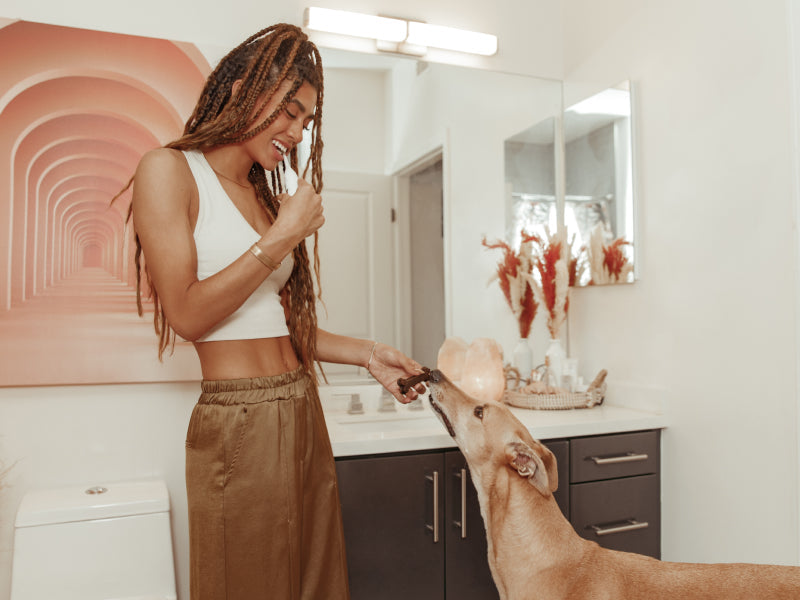Imagine what your mouth would feel like if you never brushed your teeth. Not pretty, right? Then, ask yourself this: When was the last time you brushed your dog's teeth? If you can’t remember (or the answer is “never”), keep reading.
Just like us, dogs need regular dental care to keep their teeth and gums healthy, but only 2% of pet parents brush their dog’s teeth at home and only 14% of pets receive dental care at the vet’s office. This lack of regular dog teeth cleaning leads to some pretty grim statistics:
- Dental disease affects 80% of adult dogs.
- Dental disease affects up to 96% of senior dogs over 12 years of age.
The Risks and Costs of Dental Disease in Dogs
The impact of not brushing your dog’s teeth is more serious than just bad breath. Untreated dental disease can cause pain and discomfort for our pups and can even impact our dogs’ overall health.
Without regular brushing, bacteria trapped under the gumline can enter the bloodstream and cause health problems in other areas of the body. A buildup of plaque (aka bacteria) on your dog’s teeth can eventually progress into their tooth sockets and cause bad breath, gum disease, and tooth decay. According to certified veterinarian Dr. Tammy Pearce, “Gum disease and severe gingivitis can also lead to chronic health conditions, potentially causing heart, kidney and other organ problems.”
We all want our dogs to live long and healthy lives, which is the best reason to start a regular teeth cleaning routine. The other reason? Daily preventative care can also help lessen the likelihood of expensive dental work down the line.
A deep dental cleaning in a vet’s office is a moderate procedure with a hefty price tag. A cleaning requires preparatory tests, bloodwork, and general anesthesia (being ‘put under’). If a dog needs extractions (tooth removal) a single dental cleaning can cost up to $3000.
How Often to Brush Dog Teeth
Daily tooth brushing is the gold standard, but any brushing is better than none at all. Daily dental care can seem daunting at first, but we have some tips and tricks.
If you’re having trouble remembering to brush your dog’s teeth, try “habit stacking.” Identify an ingrained habit in your own daily routine and tack on doggie dental care. For example, you could brush your dog’s teeth every evening after you brush your own teeth. Place dog toothpaste and a dog toothbrush and/or a note in the bathroom as a visual reminder to habit stack. Another idea is if you walk your dog every morning, finish the routine with a teeth cleaning session after the walk. Place your dog’s dental care kit next to the leash as a daily reminder. Before you know it, brushing your dog’s teeth will become a regular habit.

How to Brush Dog Teeth
If you’ve never brushed your dog’s teeth, don’t be intimidated! Let’s start by breaking things down step-by step.
First, you’ll want to make sure your dog is comfortable with you touching their mouth and gums. If they aren’t, you’ll need to work on getting your dog used to having their mouth handled before you try brushing. Jumping right into brushing before your dog is comfortable could unintentionally create a negative association with the dental care routine, making it hard to maintain. If your pup is extremely scared or you think they may be a bite risk, seek guidance from a certified dog trainer before starting.
Get Your Dog Used to Teeth Cleaning
Any dog parent knows to build routines that don’t require chasing your pup around the house, you have to create a positive association with that habit. Here are a few tips to help your dog get more comfortable with brushing their teeth:
- Make it a positive experience! Praise your pup and give them pets while you brush, and make them feel safe the entire time. You can also give them small treats like Jinx Training Treats to reward their good behavior. It’s also wise to choose a place and time that’s calm and quiet.
- Start out by gently rubbing your finger on the surfaces of your dog’s teeth and gums. Check in and see how your dog reacts.
- When you’re starting out, stick to brushing the outer surfaces of the front teeth first. As your dog gets more comfortable with the process, you can start to work your way to their back teeth and the inner surfaces.
Find Dog-Friendly Toothpaste and Toothbrushes
Next, make sure you have toothpaste designed for dogs (don’t use human toothpaste!) and a soft-bristled brush (this can be a human toothbrush or a dog toothbrush). Pick a flavor you know your dog will love, like poultry, beef, or seafood. Add some of the dog toothpaste to the brush and simply let your dog lick and taste the toothpaste before attempting to brush. The goal is to help your dog see the toothpaste as a treat, which will make daily brushing so much easier. Reward your pup with a few bite-sized treats along the way to solidify a positive association with the toothbrush.
You might notice there are a couple types of dog toothbrushes to choose from: a regular brush similar to human toothbrushes and a bristled brush that goes on your fingertip. Both are great options, so it’s up to you to find what’s most comfortable for you and your pup!

Read Your Dog’s Body Language
Once your dog is comfortable with the process up to this point, you can start brushing! Take plenty of breaks with ample treat rewards in between mini brushing sessions. Pay attention to your dog’s reactions and go at their pace. If they try to pull away or show you any signs of distress, stop for the day and try again tomorrow. If you notice any blood on the toothbrush, you may have brushed too hard or for too long.
For more detailed instructions with tips from certified dog trainer Erika Gonzalez, watch our step by step video guide.
Soon, you’ll have your dog toothbrush and toothpaste ready to go at all times!
Can I Clean My Dog’s Teeth Without Brushing?
While there’s no replacement for daily brushing and regular vet check-ups, you can help keep your dog’s teeth clean and breath fresh with a daily dental chew. Chewing increases blood flow to help release tartar build up that leads to dental disease and bad breath.
Jinx dental chews are one of the most limited ingredient dental chews on the market. (We dare you to compare our ingredient list to Greenies.) With only sweet potato, chicken, honey, and peppermint oil, Jinx chews are easy-to-digest and low-calorie. The best part? They have a taste your dog will beg for and an extended chew time that will keep your dog engaged.
Upkeeping Your Dog’s Dental Health
So, you’ve mastered brushing your pup’s teeth. Good job! Now, let’s cover how to keep up the momentum and create lifelong habits that support healthy teeth and gums.
- Create a schedule (for both you and your dog!). This will encourage you to keep up the routine, and your dog to get more comfortable with (and maybe even enjoy) having their teeth brushed.
- Add dry dog food to their diet. Dry kibble can help your pup stimulate their chewing muscles and provides a gentle massage to clean their teeth and gums.
- Give one dental chew daily to help fight tartar and plaque build-up while your dog chews. Added bonus: Fresh breath for more enjoyable kisses.

